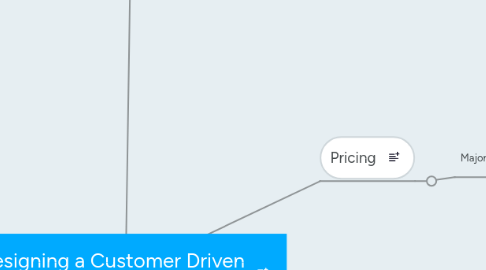
1. Marketing Channels
1.1. SupplayChains and the Value Delivery Network
1.1.1. Supply chain consist of
1.1.1.1. Upstream Partner
1.1.1.1.1. Supplier of...
1.1.1.2. Downstream Partner
1.1.1.2.1. Marketing Channels
1.1.2. Views
1.1.2.1. Supply Chain
1.1.2.2. Demand Chain
1.1.2.3. Value delivery network
1.2. The Nature of importance of Marketing Channels
1.2.1. How channel Members add value
1.2.1.1. Intermediares create greater efficiency
1.2.1.2. Role of marketing intermediares
1.2.1.3. Key Functions of Marketing Channel Members
1.2.1.3.1. Information
1.2.1.3.2. Promotion
1.2.1.3.3. Contact
1.2.1.3.4. Matching
1.2.1.3.5. Negotiation
1.2.1.3.6. Financing
1.2.1.3.7. Risk taking
1.2.1.3.8. Physical distribution
1.2.2. Number of Channel Levels
1.2.2.1. Direct Marketing Channels
1.2.2.2. Indirect Marketing Channels
1.2.2.3. flows
1.2.2.3.1. physical flow
1.2.2.3.2. flow of ownership
1.2.2.3.3. payment flow
1.2.2.3.4. information flow
1.2.2.3.5. promotion flow
1.3. Channel Behavior and Organizations
1.3.1. Channel Behavior
1.3.1.1. Horizontal Conflicts
1.3.1.2. Vertical Conflicts
1.3.2. Vertical Marketing Systems
1.3.2.1. Corporate VMS
1.3.2.2. Contractual VMS
1.3.2.2.1. manufacturer sponsored retailer system
1.3.2.2.2. manufacturer sponsored wholeseller system
1.3.2.2.3. service firm sponsored retailer frenchise system
1.3.2.3. Administered VMS
1.3.3. Building Logistic Partnerships
1.3.3.1. cross functional teams
1.3.3.2. shared projects
1.3.4. Horizontal Marketing System
1.3.5. Multichannel Distributions Systems
1.3.6. Changing Channel Organization
1.3.6.1. Desintermmediation
1.4. Channel Design Decisions
1.4.1. Analyzing Consumer Needs
1.4.2. Setting Channel Objectives
1.4.3. Identifying Major Alternatives
1.4.3.1. Types of Intermediaries
1.4.3.2. Number of Marketing Intermediaries
1.4.3.2.1. Intensive distribution
1.4.3.2.2. Exclusive distribution
1.4.3.2.3. Selective distribution
1.4.3.3. Responsibilities of Channel Members
1.4.4. Evaluating the Major Alternatives
1.4.4.1. evaluated against
1.4.4.1.1. economic
1.4.4.1.2. control
1.4.4.1.3. adaptability criteria
1.4.5. Designing International Distribution Channels
1.5. Channel Management Decisions
1.5.1. Selecting Channel Members
1.5.1.1. years in business
1.5.1.2. other lines carried
1.5.1.3. location
1.5.1.4. growth/profit record
1.5.1.5. cooperativeness
1.5.1.6. reputation
1.5.2. Managing and Motivating Channel Members
1.5.3. Evaluating Channel Members
1.6. Public Policy and Distribution Decisions
1.6.1. strategies
1.6.1.1. exclusive distribution
1.6.1.2. exclusive dealing
1.6.1.3. full time forcing
1.7. Marketing Logistics and Supply Chain Management
1.7.1. Nature and Importance of Marketing Logistics
1.7.1.1. customer centered logistic
1.7.1.2. involves
1.7.1.2.1. outbound logistic
1.7.1.2.2. inbound logistics
1.7.1.2.3. reverse logistics
1.7.2. Goals of the Logistic Systems
1.7.3. Major Logistic Functions
1.7.3.1. Warehousing
1.7.3.1.1. storage warehouse
1.7.3.1.2. distribution center
1.7.3.2. Inventory Management
1.7.3.2.1. just in time logistic systems
1.7.3.3. Transportation
1.7.3.3.1. Trucks
1.7.3.3.2. railroads
1.7.3.3.3. water carriers
1.7.3.3.4. air
1.7.3.3.5. internet
1.7.3.3.6. intermodel transportations
1.7.3.4. Logistic Information Management
1.7.3.4.1. electronic data interchange
1.7.3.4.2. vendor managed inventory
1.7.4. Integrated Logistics Management
1.7.4.1. Cross Functional Teamwork
1.7.4.1.1. Permanent logistic committees
1.7.4.1.2. Supply Chain Manager positions
1.7.4.1.3. System wide supply chain management software
1.7.4.2. Third Party Logistics (3PL) providers
2. New Product Development
2.1. Product Development
2.1.1. New Product Development Strategies
2.1.1.1. reasons for failing
2.1.1.1.1. overestimation of market size
2.1.1.1.2. poorly designed
2.1.1.1.3. incorrectly positioned
2.1.1.1.4. price to high
2.1.1.1.5. developing cost to high
2.1.2. New Product Development Process
2.1.2.1. Idea generation
2.1.2.1.1. Internal Idea Sources
2.1.2.1.2. External Data Sources
2.1.2.1.3. Crowdsourcing
2.1.2.2. Idea Screening
2.1.2.3. Concept Development and Testing
2.1.2.3.1. distinguish between
2.1.2.3.2. Concept Developing
2.1.2.3.3. Concept Testing
2.1.2.4. Marketing Strategy Development
2.1.2.4.1. marketing strategy statement
2.1.2.5. Business Analysis
2.1.2.6. Product Development
2.1.2.7. Test marketing
2.1.2.7.1. stadart test market
2.1.2.7.2. controlled test market
2.1.2.7.3. simulated test market
2.1.2.8. Commercialization
2.1.3. Managing New Product Development
2.1.3.1. Custimer Centered New Product development
2.1.3.2. Team Based New Product Development
2.1.3.3. Systematic New Product Development
2.2. Product Life Cycle
2.2.1. Product Life Cycle Strategies
2.2.1.1. Product Development
2.2.1.2. Introduction
2.2.1.3. Growth
2.2.1.4. Materity
2.2.1.5. Decline
2.2.2. Product Life Concept
2.2.2.1. Product Class
2.2.2.2. Product Form
2.2.2.3. Brand
2.2.2.4. PLC can be applied to
2.2.2.4.1. Styles
2.2.2.4.2. Fashion
2.2.2.4.3. Fads
2.3. Additonal Product Sercice Coniderations
2.3.1. Product Decisions and Social Responsibility
2.3.2. International Product and Service Marketing
3. Pricing
3.1. Major Pricing Strategies
3.1.1. Customer Value Based Pricing
3.1.1.1. Good Value Pricing
3.1.1.1.1. Good Value Pricing
3.1.2. Strategies
3.1.3. Strategies
